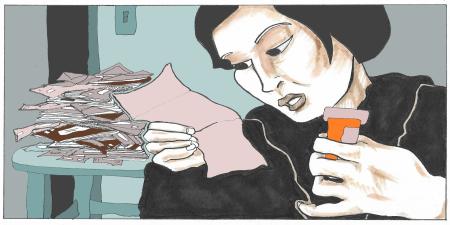Abstract
Long-acting injectable antiretroviral therapy (LA-ART) is a powerful new addition to the treatments available for patients living with HIV, but broad acceptance and uptake could be compromised by what we know about patients’ and clinicians’ experiences with long-acting injectable antipsychotics (LAI-APs). Treatment of stigmatized conditions, such as psychiatric illness or HIV, using long-acting injection is ethically fraught with patients’ fear of coercion and forced administration. Strategies that emphasize patient-centered, patient-directed care and that place limits on when LAI can be administered forcibly can help promote LA-ART’s acceptance and use.
Comparing LA-ART and LAI-APs
Long-acting injectable antiretroviral therapy (LA-ART) is effective for treatment and prevention of HIV. A once-monthly injectable formulation of the medications cabotegravir and rilpivirine was approved by the US Food and Drug Administration for treatment of HIV in certain patients in January 2021.1 The first radical reimagining of HIV treatment in nearly 25 years, LA-ART offers enormous promise for people living with HIV and for the Ending the HIV Epidemic program, which seeks to reduce new infections at least 90% by 2030.2 Participants in studies of LA-ART have reported favorable views of its convenience and simplicity.3 Yet ethical questions related to these and other anticipated benefits of LA-ART should be explored.
Similarities between LA-ART and long-acting injectable antipsychotics (LAI-APs) and structural and sociocultural overlaps between HIV and psychiatric illnesses suggest that their comparison is useful. Although HIV and psychiatric illness are very different in terms of both biology and lived experience, both diagnoses have historically been stigmatized. Additionally, both HIV and psychiatric illness disproportionately affect marginalized populations, with higher burdens and worse outcomes among people of color, people of marginalized gender and sexual identities, people living in poverty, and people who are incarcerated.4 HIV and psychiatric illness are also recognized as important to public health and safety: HIV is a communicable disease and psychiatric illness is one of several syndemic burdens connected to joblessness, homelessness, and crime.5 In consequence, patients with HIV and psychiatric illness are subject to special legal privacy protections as well as protective and criminalizing statutes.6,7 Finally, care of patients with HIV and patients with psychiatric illness each has fraught ethical, clinical, and public health histories, and some clinicians have (perhaps unwittingly) participated in patients’ stigmatization, marginalization, and mistreatment.
Patient Experiences of LAIs
When treated orally, both HIV and pharmacologically managed psychiatric illnesses (eg, schizophrenia) typically require at least once-daily pills and long-term adherence for treatment success. LAIs can be used to (and were indeed designed to) promote adherence, since they are administered in-clinic as shots, 3 to 12 weeks apart. While most oral medications are self-administered, injectable medications are administered by clinicians; this is ethically relevant for 3 reasons: (1) clinicians’ authority can cause anxiety for patients, (2) the long-acting nature of the drug effectively requires therapy continuation with no way to opt-out for weeks or months, and (3) in-clinic administration of LAIs enables close adherence monitoring, which some patients experience as intrusive.8
Clinicians’ authority can cause anxiety for patients.
Likely designed with good intention to make it easier to adhere, LAIs have an ethically relevant side-effect: they restrict patients’ liberty while administered medications endure in their bodies. Clinicians have centered this effect in decisions to treat patients with LAI-APs; the drugs may be regarded as a “treatment of last resort” and are often recommended for patients thought to have severe or refractory illnesses, nonadherence, lack of insight, or treatment “failure.”9 Although LAI-APs demonstrate benefits to patients at all phases of psychotic illness and more than half of psychiatrists in one survey consider them for patients who experience multiple relapses, only 10% of surveyed psychiatrists recommend them to newly diagnosed patients.10 Patients who have never used LAI-APs report negative attitudes about the drugs and pessimism about their purported benefits, even though patients with long-term experience with the same medications report favorable views.11 These dimensions of patients’ and clinicians’ experience with LAI-APs suggest the importance of considering the impact of similar features of LA-ART. LA-ART should not be presented as a solution to nonadherence but instead should be seen as a way to promote equity in treating all patients with HIV. LA-ART should be broadly available such that patient-centered treatment goals like U = U (undetectable viral load equals untransmissible virus) are obtainable.
Equity, Coercion, and Force
LAIs can be perceived as coercive and as prioritizing clinical or social goals over patients’ self-determination. Some patients feel that LAI-APs, as opposed to oral antipsychotics, restrict their autonomy, and 68% of surveyed psychiatrists agree that patients taking medication by choice are more likely to be taking oral antipsychotics than LAI-APs.12 Compared to patients treated orally, patients for whom LAI-APs are prescribed are more likely to be people of color, have a police history, or have a substance use disorder. It is unclear whether prescribing practices differ due to clinician preferences or need, patient preferences or need, or clinician biases that prompt clinicians to direct therapy to promoting adherence.13 LAI-APs can be also used forcibly for court-ordered inpatient or outpatient treatment for patients who lack decision-making capacity because of severe psychiatric illness. Such treatment plans can be developed between a patient and physicians to promote that patient’s best interest.14 In criminal courts, LAI-APs can be used to restore a defendant’s competency to stand trial, to treat patients experiencing incarceration, or to help meet a person’s conditions for supervised release from incarceration, all of which treatment plans may consider interests external to the patient.15,16
While involuntary administration of short-acting or long-acting antipsychotics is common, involuntary HIV care is very unusual, because HIV does not directly impair decision-making capacity. In addition, long-term willingness and ability to adhere to treatment are key indicators of a patient’s readiness to start ART, because sporadic treatment can lead to antiretroviral resistance.17 These differences between LAI-APs and LA-ART suggest that LA-ART would be unlikely to be used to treat patients involuntarily for HIV. In the most plausible scenario, patients with HIV who lack capacity to make health decisions could be treated forcibly with LA-ART but with an appropriate surrogate’s consent, based on substituted judgment or the patient’s best interest.18
LA-ART could possibly be used to forcibly treat patients with HIV who lack decision-making capacity (ie, as court-ordered treatment), but extant laws would likely have to be construed to justify force in an extreme case. Many states’ laws criminalize nondisclosure of one’s HIV-positive status (often targeting people with HIV experiencing incarceration), and there is legal precedent for public health-mandated treatment of sexually transmissible infections, including HIV.19 But these laws should not be understood as broad legal or ethical endorsement of forced HIV care, a violation of patients’ autonomy that is unlikely to result in long-term treatment adherence. In fact, to continue to advance HIV decriminalization efforts, health professionals should neither support nor participate in court-ordered HIV treatment.20
Navigating Novelty
LA-ART, like LAI-APs for psychiatric illness, expands treatment options available to people living with HIV, offering convenience, continuity of care, privacy (eg, for patients uncomfortable storing medications used to treat stigmatized illnesses), and adherence support. As discussed here, adherence promoted via LAIs decreases risk of relapse and slows disease progression, but whether LAIs are prescribed also reflects clinicians’ preferences or bias and patients’ preferences or needs. Clinicians can work with patients to address any anxiety, reservations about lack of opt-out opportunity, or discomfort with increased monitoring and to ensure that LAIs support patients’ health goals, align with their preferences and needs, and promote health equity. Lessons from experience with LAI-APs illuminate clinically and ethically relevant similarities and differences between LAI-APs and LA-ART and can help early adopters and leaders to deploy LA-ART in ways that promote broad acceptance of an important novel therapy for responding to needs and vulnerabilities of patients with HIV.
References
-
Highleyman L. FDA approves cabenuva, the first complete long-acting injectable HIV treatment. POZ. January 21, 2021. Accessed January 26, 2021. https://www.poz.com/article/fda-approves-cabenuva-first-complete-longacting-injectable-hiv-treatment
-
Office of Infectious Disease and HIV/AIDS Policy, US Department of Health and Human Services. What is Ending the HIV Epidemic: A Plan for America? HIV.gov. Accessed December 4, 2020. Updated February 23, 2021. https://www.hiv.gov/federal-response/ending-the-hiv-epidemic/overview
- Kerrigan D, Mantsios A, Grant R, et al. Expanding the menu of HIV prevention options: a qualitative study of experiences with long-acting injectable cabotegravir as PrEP in the context of a phase II trial in the United States. AIDS Behav. 2018;22(11):3540-3549.
- Viswasam N, Schwartz S, Baral S. Characterizing the role of intersecting stigmas and sustained inequities in driving HIV syndemics across low-to-middle-income settings. Curr Opin HIV AIDS. 2020;15(4):243-249.
- Keers R, Ullrich S, Destavola BL, Coid JW. Association of violence with emergence of persecutory delusions in untreated schizophrenia. Am J Psychiatry. 2014;171(3):332-339.
-
HIV and STD criminal laws. Centers for Disease Control and Prevention. Reviewed December 21, 2020. Accessed March 9, 2021. https://www.cdc.gov/hiv/policies/law/states/exposure.html#:~:text=In%2021%20states%2C%20laws%20require,negligible%20risk%20for%20HIV%20transmission
-
US Department of Health and Human Services. Information related to mental and behavioral health, including opioid overdose. HHS.gov. Reviewed June 4, 2020. Accessed June 24, 2020. https://www.hhs.gov/hipaa/for-professionals/special-topics/mental-health/index.html
- Roberts LW, Geppert CM. Ethical use of long-acting medications in the treatment of severe and persistent mental illnesses. Compr Psychiatry. 2004;45(3):161-167.
- Iyer S, Banks N, Roy MA, et al. A qualitative study of experiences with and perceptions regarding long-acting injectable antipsychotics: part II—physician perspectives. Can J Psychiatry. 2013;58(5)(suppl 1):23S-29S.
- Jaeger M, Rossler W. Attitudes towards long-acting depot antipsychotics: a survey of patients, relatives and psychiatrists. Psychiatry Res. 2010;175(1-2):58-62.
-
Pietrini F, D’Anna G, Tatini L, et al. Changes in attitude towards LAI antipsychotic maintenance treatment: a two-year follow-up study. Eur Psychiatry. 2018;53:58-65.
- Patel MX, Haddad PM, Chaudhry IB, McLoughlin S, Husain N, David AS. Psychiatrists’ use, knowledge and attitudes to first- and second-generation antipsychotic long-acting injections: comparisons over 5 years. J Psychopharmacol. 2010;24(10):1473-1482.
-
Stahl SM. Long-acting injectable antipsychotics: shall the last be first? CNS Spectr. 2014;19(1):3-5.
- Cusimano J, VandenBerg A. Long-acting injectable antipsychotics and their use in court-ordered treatment: a cross-sectional survey of psychiatric pharmacists’ perceptions. Ment Health Clin. 2020;10(1):18-24.
- Ghossoub E, Minchin S, Hayreh D, Newman WJ. Long-acting injectable versus oral antipsychotics for restoration of competency to stand trial. J Am Acad Psychiatry Law. 2019;47(4):440-447.
- Salem A, Kushnier A, Dorio N, Reeves R. Nonemergency involuntary antipsychotic medication in prison: effects on prison inpatient days and disciplinary charges. J Am Acad Psychiatry Law. 2015;43(2):159-164.
-
Cevik M, Orkin C, Sax PE. Emergent resistance to dolutegravir among INSTI-naïve patients on first-line or second-line antiretroviral therapy: a review of published cases. Open Forum Infect Dis. 2020;7(6):ofaa202.
- Lindemann H. The intimate responsibility of surrogate decision-making. Hastings Cent Rep. 2018;48(1):41-42.
-
Center for HIV Law and Policy. HIV Criminalization in the United States: A Sourcebook on HIV Criminal Law and Practice. 3rd ed. Accessed March 9, 2021. https://www.hivlawandpolicy.org/sites/default/files/HIV%20Criminalization%20in%20the%20U.S.%20A%20Sourcebook%20on%20State%20Fed%20HIV%20Criminal%20Law%20and%20Practice%20050520.pdf
- Barney JL. Louisiana’s intentional exposure to HIV policy: the social construction of target populations. Soc Work Public Health. 2020;35(3):100-113.



